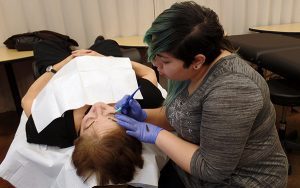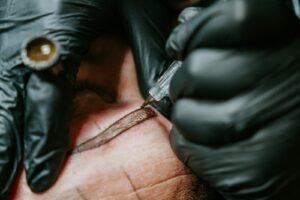Permanent Makeup: Understanding Micropigmentation, Risks, and Adverse Effects
At Cameo College, we aim to equip our students with comprehensive knowledge about various beauty techniques, including permanent makeup. This innovative cosmetic solution offers a long-lasting alternative to traditional makeup application, allowing individuals to enhance their features with minimal daily effort. However, understanding the intricacies, potential risks, and adverse effects associated with permanent makeup is crucial for future professionals. In this article, we delve into the world of micropigmentation, exploring how it works, common areas of application, and the considerations one must keep in mind before opting for this procedure.
What is Permanent Makeup?

Permanent makeup, also known as micropigmentation, is a cosmetic technique that involves the application of tattoo ink to the skin to mimic conventional makeup. Unlike regular tattoos, this process uses pigments specifically formulated for facial areas such as eyebrows, eyelids, and lips. The technique aims to enhance natural features, providing a solution for those with physical challenges of applying makeup or who desire a polished look without the daily effort. By understanding the intricacies of microneedles and tattoo procedures, students can better appreciate the artistry and precision required in creating natural-looking results.
Definition of Micropigmentation
Micropigmentation is a specialized form of tattooing that involves depositing pigments into the dermal layer of the skin. This process is often performed using a tattoo gun or a hand-held device designed for precision. Unlike traditional tattoo procedures, micropigmentation uses a finer needle and lighter tattoo pigment to create subtle, natural-looking enhancements. The pigments used are typically composed of iron oxide, which is safe for cosmetic use and compatible with most skin types. Understanding the science behind micropigmentation is crucial for aspiring beauty professionals aiming to master this transformative technique.
How Permanent Makeup Works
The process of getting permanent makeup begins with a thorough consultation to determine the best approach for each individual’s skin color and desired outcome. During the procedure, a skilled technician uses a tattoo gun to deposit permanent makeup inks into the targeted areas, such as the eyebrows or eyelids. The depth and precision of the ink placement are carefully managed to achieve the desired aesthetic effect. It is essential for students to understand the nuances of different skin types and the potential for adverse effects such as swelling or burning in the treated area. Mastery of this technique ensures safe and successful outcomes for clients.
Common Areas for Application

Photo by Gunnar Bjarki on Unsplash
Permanent makeup is most commonly applied to areas of the face where individuals traditionally use cosmetic products. The eyebrows are a popular choice, providing a solution for those who have sparse or uneven brows. Permanent eyeliner and eyelash enhancements are also sought-after, offering a smudge-proof and long-lasting alternative to traditional eye makeup. Other areas include the lips, where pigmentation can enhance the natural lip color and shape.
| Area | Benefits |
|---|---|
| Eyebrows | Solution for sparse or uneven brows |
| Eyes (Eyeliner and Eyelash Enhancements) | Smudge-proof and long-lasting alternative |
| Lips | Enhances natural lip color and shape |
Students must be proficient in assessing the appropriate application techniques for each area, ensuring that the results are both safe and aesthetically pleasing for clients.
Types of Permanent Makeup

Photo by Gabe Pierce on Unsplash
Cosmetic Tattoos Explained
Cosmetic tattoos, or permanent makeup, represent a fascinating intersection between art and science, offering a transformative approach for those seeking lasting beauty enhancements. Unlike traditional tattoos, cosmetic tattoos use specialized tattoo pigments, often derived from iron oxide, to replicate makeup effects on areas such as the eyebrows, eyelids, and lips. This technique involves depositing pigment into the dermal layer of the skin, providing long-lasting color that mimics applied makeup. Future makeup artists will find that understanding the nuances of color theory and skin types is crucial in creating natural-looking, aesthetically pleasing results for clients seeking these procedures.
Popular Eye Makeup Techniques
When discussing permanent eye makeup, popular techniques include permanent eyeliner and eyelash enhancements. These options provide a smudge-proof solution for those who want defined eyes without the daily effort of applying eyeliner or mascara. During the procedure, a skilled technician uses a tattoo gun to deposit pigments along the lash line, creating the appearance of fuller lashes or a defined eye contour. Understanding the potential risks of permanent makeup, such as redness or swelling, is essential for professionals to ensure safe practices and desirable outcomes for clients. Mastery of these techniques can significantly enhance a makeup artist’s repertoire.
Other Cosmetic Options
Beyond the eyes, permanent makeup offers a range of cosmetic options to address various beauty needs. Lip pigmentation is a popular choice, enhancing natural lip color and giving the illusion of fuller lips. For those with sparse eyebrows, micropigmentation can create the appearance of fuller, more defined brows, which is especially beneficial for individuals facing physical challenges of applying makeup. However, it’s important to be aware of potential adverse events, such as allergic reactions or pigmentation changes. Aspiring beauty professionals must be well-versed in assessing skin types and understanding the pigments used to ensure safe and effective procedures.
Understanding the Risks of Permanent Makeup

Photo by Diana Polekhina on Unsplash
Potential Adverse Effects
As with any cosmetic procedure, permanent makeup carries certain risks and potential adverse effects that students must be aware of. Common issues can include redness, swelling, or even burning in the treated area immediately after the procedure. In some cases, individuals may experience an allergic reaction to the tattoo ink, particularly if they have sensitive skin or a history of allergies. It’s crucial for aspiring makeup artists to understand these risks to effectively communicate them to clients and ensure that informed decisions are made. Additionally, there is a risk of infection if the micropigmentation procedures are not performed under sterile conditions, emphasizing the need for proper training and hygiene practices.
Is Permanent Makeup Safe?
When performed by trained professionals, permanent makeup is generally considered safe. However, the safety of permanent makeup is contingent upon several factors, including the skill of the technician, the quality of the pigments used, and the client’s skin type. The pigments, often derived from iron oxide, are formulated to be compatible with most skin types, but it is vital to perform patch tests to rule out any potential allergic reactions. Another consideration is the compatibility with medical procedures, such as MRI scans, where certain tattoo pigments can cause discomfort. Students must be thoroughly educated on these aspects to ensure the safety and satisfaction of their clients.
Consultation and Considerations
A thorough consultation is an essential step before any permanent makeup procedure. During this initial meeting, the technician should assess the client’s skin color, discuss desired outcomes, and identify any potential health risks or contraindications. This is also the time to address any concerns regarding the adverse effects or health risks associated with the procedure, such as the potential for pigmentation changes or the rare occurrence of loss of eyelashes. Students at Cameo College are trained to conduct comprehensive consultations, providing clients with a clear understanding of what to expect and ensuring that they are well-informed before making the decision to proceed with permanent makeup.
Permanent Makeup and Medical Considerations

Photo by National Cancer Institute on Unsplash
Impact on MRI Procedures
Permanent makeup, while generally safe, can have implications during certain medical procedures such as MRI (Magnetic Resonance Imaging) scans. The pigments used in micropigmentation, especially those containing iron oxide, can interact with the magnetic fields of the MRI, potentially causing discomfort or a tingling sensation in the tattoo area. Although adverse effects are rare, it’s important for clients to inform medical professionals about any permanent makeup they have before undergoing an MRI. Understanding these interactions is crucial for makeup artists, ensuring they provide comprehensive information to clients regarding the potential health risks associated with permanent cosmetic procedures.
Consulting with Professionals
Before getting permanent makeup, it is essential for clients to consult with experienced professionals who can provide guidance on the procedure’s suitability, considering the client’s skin type and health history. Professional consultations should address potential risks of permanent makeup, such as redness, swelling, or allergic reactions to tattoo ink. At Cameo College, we emphasize the importance of thorough consultations, where makeup artists assess the client’s skin color and discuss desired outcomes. This process aids in identifying any contraindications and ensures that clients are fully informed about the micropigmentation procedures, leading to safe and satisfactory results.
Post-Procedure Care
Proper post-procedure care is vital to ensure the longevity and safety of permanent makeup. After the procedure, clients may experience swelling or burning in the treated area, which can be mitigated with appropriate aftercare. This includes keeping the pigmented area clean, avoiding direct sunlight, and refraining from applying makeup to the area until it has fully healed. Understanding the nuances of post-procedure care helps prospective makeup artists at Cameo College equip their clients with the knowledge needed to maintain their new cosmetic tattoos effectively. By adhering to recommended care guidelines, clients can reduce the risk of adverse events and ensure optimal healing.

